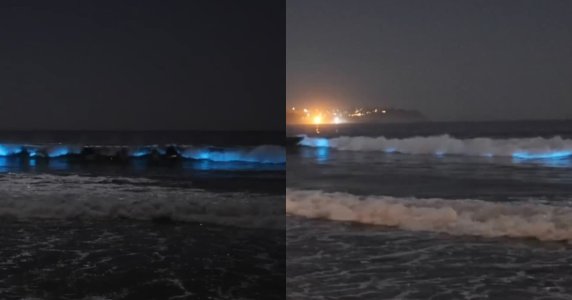Incredible phenomenon turns Aussie beach into a bright blue wonderland! But is it safe?
By
VanessaC
- Replies 3
A spectacular natural phenomenon had Aussies flocking to Manly Beach in Sydney over the weekend as waves lit up in a dazzling display of neon blue lights.
The magical sight was caused by bioluminescence, which is when plankton in the ocean produce a glowing blue light through a chemical reaction.
Large amounts of bioluminescence happen when the ocean is disturbed by waves or movement in the water, which agitates the organisms emitting the ghostly glow.
The organisms, called dinoflagellates, are the most common type of bioluminescent algae on the ocean surface. Conditions such as changes in the sea temperature and a decrease in the saltiness of the water can sometimes prompt these dinoflagellates to glow continuously.
While it can happen anywhere in the world, Australia has some particularly good spots to see it.
Manly Beach in Sydney is one such hotspot, with the aforementioned event being captured there this weekend, and even back in August. Residents shared on social media photos that showed the beach sparkling in blue over the weekend.
Down south, the waters around Jervis Bay on the South Coast of New South Wales are also famous for hosting bioluminescence.
On land, known bioluminescent organisms are fireflies and certain fungi.
You can watch the full video of Manly Beach filled with Bioluminescent algae below:
Source: Facebook/Haig Gilchrist.
Glowing water along the beach is quite a sight—but is it safe?
Despite the mesmerising view it offers, it may be a warning sign of danger as some bioluminescent species of dinoflagellates are toxic as they can be poisonous to fish and humans who come in contact.
However, other species, like the sea sparkle, are not classified as poisonous to humans, but may still bring unpleasant side effects.
Furthermore, studies have shown that the presence of bioluminescent organisms can signify negative changes in the environment, such as pollution and global warming.
Perhaps it would be wise to avoid swimming in bioluminescent waters and to just enjoy their glow from a safe distance.
In other news, an Aussie fisherman in the picturesque Wapengo Estuary stumbled upon an event that was described as a 'once-in-a-lifetime phenomenon'—a vast stretch of a school of Australian salmon that could be seen from kilometres away!
The aerial footage provided a captivating view of the Australian salmon school, bustling with various marine creatures like dolphins, sharks, and seals.
'It's always wonderful sightseeing these fish in such numbers,' the fisherman, Adam Dowton said.
'It’s the biggest school of salmon on record,' Fishing Australia TV also confirmed.
You can read more about this phenomenon here!
 Members, have you seen such a phenomenon in your area? Share your experience (photos are welcome too!) in the comments below!
Members, have you seen such a phenomenon in your area? Share your experience (photos are welcome too!) in the comments below!
The magical sight was caused by bioluminescence, which is when plankton in the ocean produce a glowing blue light through a chemical reaction.
Large amounts of bioluminescence happen when the ocean is disturbed by waves or movement in the water, which agitates the organisms emitting the ghostly glow.
The organisms, called dinoflagellates, are the most common type of bioluminescent algae on the ocean surface. Conditions such as changes in the sea temperature and a decrease in the saltiness of the water can sometimes prompt these dinoflagellates to glow continuously.
While it can happen anywhere in the world, Australia has some particularly good spots to see it.
Manly Beach in Sydney is one such hotspot, with the aforementioned event being captured there this weekend, and even back in August. Residents shared on social media photos that showed the beach sparkling in blue over the weekend.
Down south, the waters around Jervis Bay on the South Coast of New South Wales are also famous for hosting bioluminescence.
On land, known bioluminescent organisms are fireflies and certain fungi.
You can watch the full video of Manly Beach filled with Bioluminescent algae below:
Source: Facebook/Haig Gilchrist.
Glowing water along the beach is quite a sight—but is it safe?
Despite the mesmerising view it offers, it may be a warning sign of danger as some bioluminescent species of dinoflagellates are toxic as they can be poisonous to fish and humans who come in contact.
However, other species, like the sea sparkle, are not classified as poisonous to humans, but may still bring unpleasant side effects.
Furthermore, studies have shown that the presence of bioluminescent organisms can signify negative changes in the environment, such as pollution and global warming.
Perhaps it would be wise to avoid swimming in bioluminescent waters and to just enjoy their glow from a safe distance.
In other news, an Aussie fisherman in the picturesque Wapengo Estuary stumbled upon an event that was described as a 'once-in-a-lifetime phenomenon'—a vast stretch of a school of Australian salmon that could be seen from kilometres away!
The aerial footage provided a captivating view of the Australian salmon school, bustling with various marine creatures like dolphins, sharks, and seals.
'It's always wonderful sightseeing these fish in such numbers,' the fisherman, Adam Dowton said.
'It’s the biggest school of salmon on record,' Fishing Australia TV also confirmed.
You can read more about this phenomenon here!
Key Takeaways
- Locals on Sydney's Northern Beaches gathered to witness a spectacular natural phenomenon called bioluminescence, transforming the surf into a glowing sea of neon blue.
- The incredible display results from a chemical reaction within certain organisms producing light.
- Manly residents posted images of the dazzling display on social media, attracting dozens of locals to the beach.
- Bioluminescence thrives in still, warm sea conditions and Jervis Bay, on the NSW South Coast, is also well-known for hosting this incredible phenomenon.








